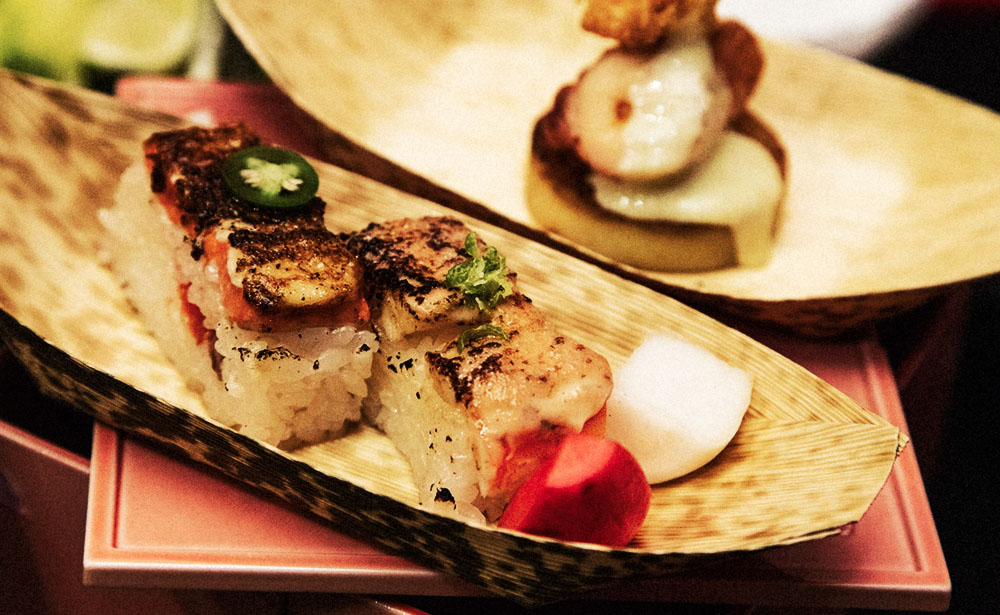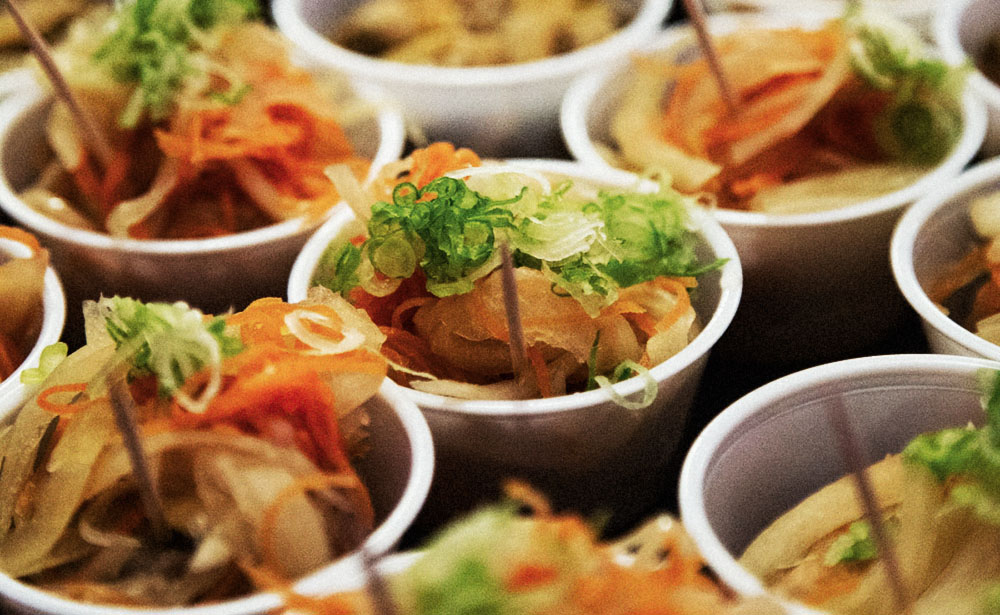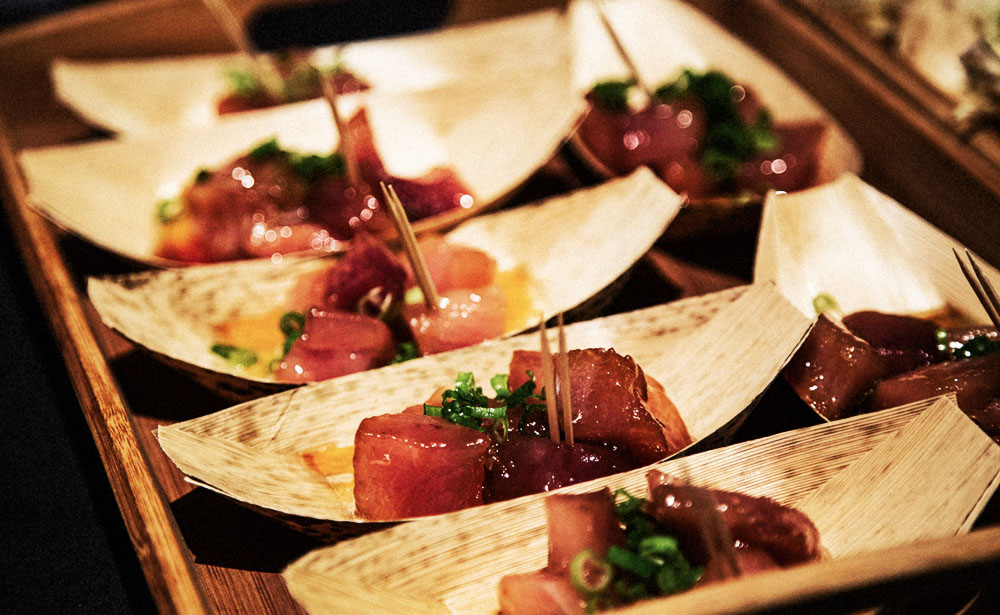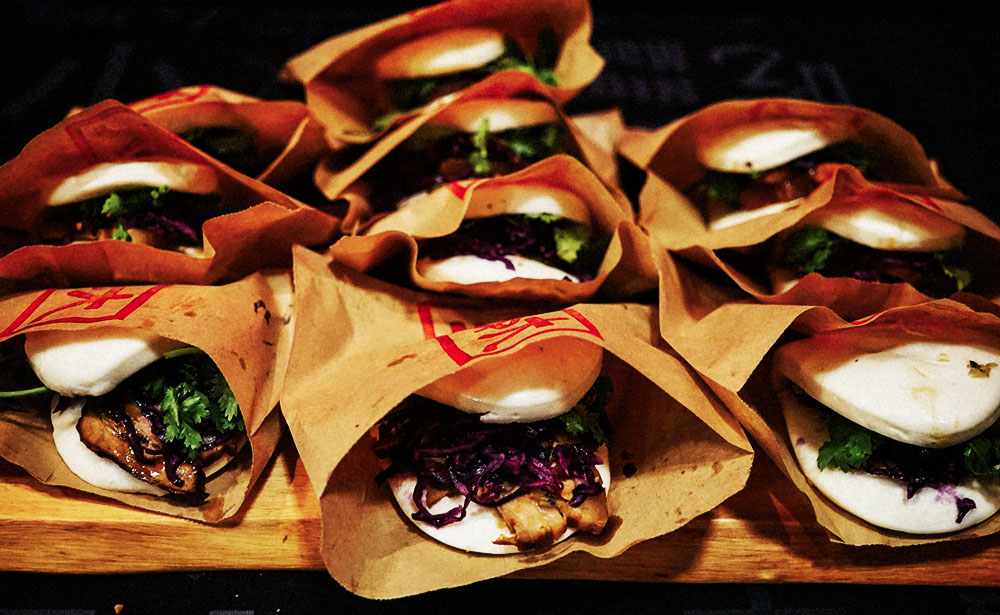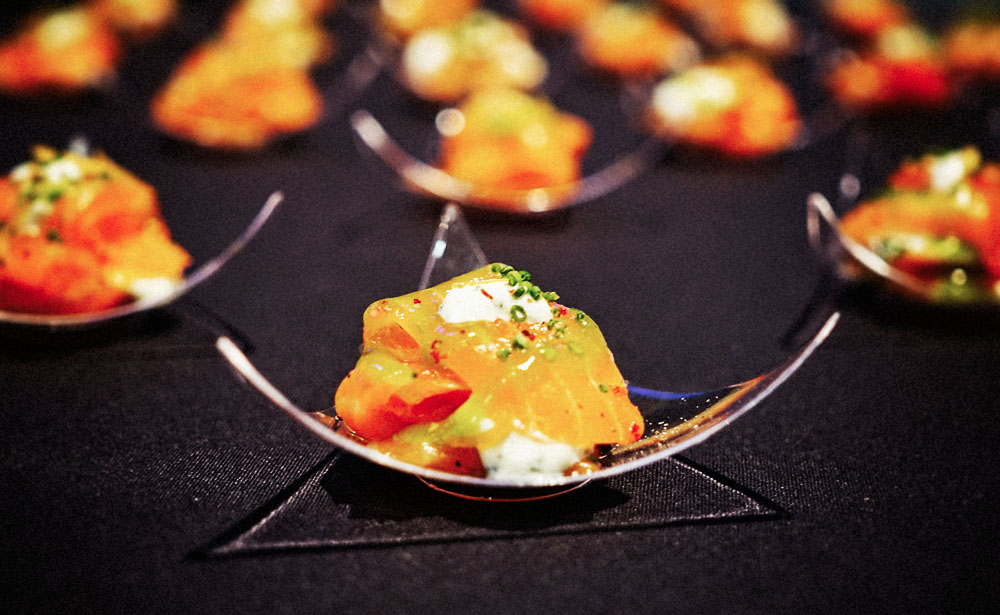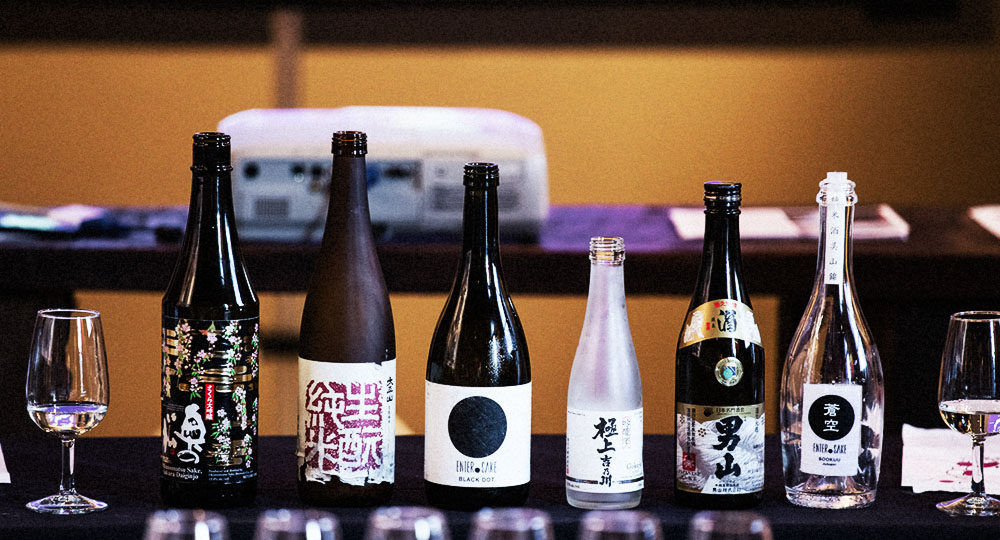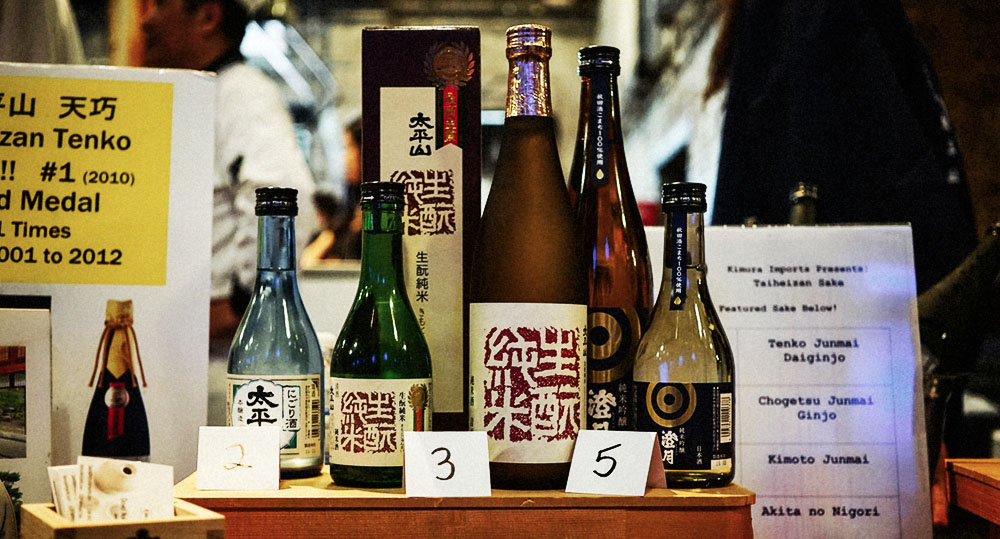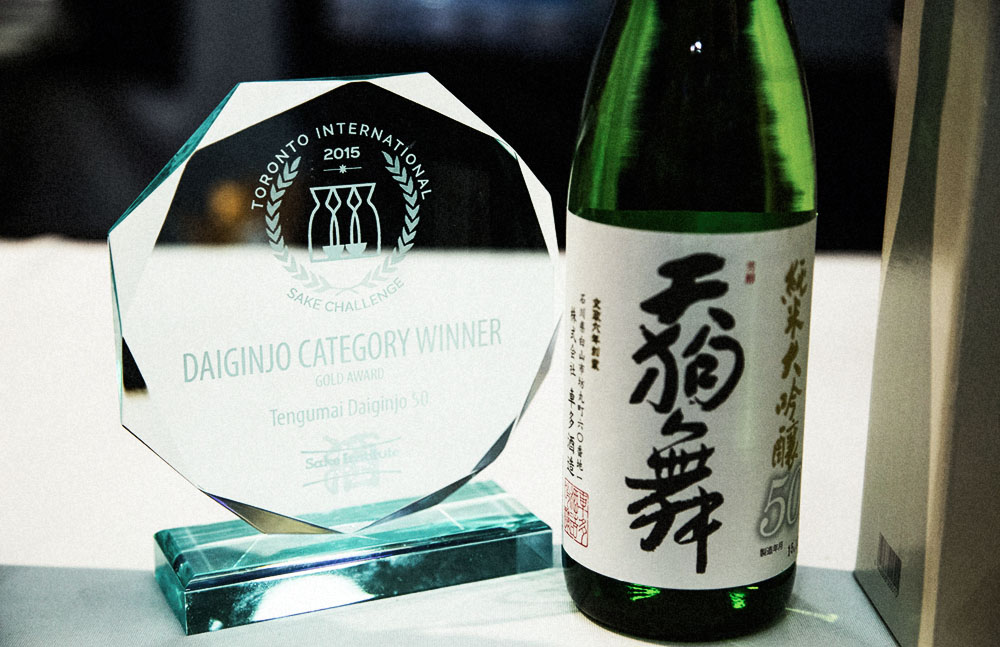The link between sake
Course 1
By Chef Scott Vivian
Striped Bass / Fish Broth / Jalapeño / Cilantro
Course 2
By Chef Nick Liu
Crispy 90-Day Chili Beef with Szechuan Peppercorn Pastrami / Pickled Wild Leeks / Grilled Garlic Scapes / Fried Chili
Course 3
By Chef Richie Nakano
Toroniku / Marinated Negi / Soft Egg, Seeds
Course 4
By Chef Bertrand Alépée
Chocolate / Sesame Tea / Rhubarb
Course 5
By Chef David H. Chow
Yuzu / Bergamot / Lime + White Chocolate-wrapped Caramel / Caramelized Hazelnut
Milk Chocolate Dragée with Kinako Sake Kasu / Honey
Sake Bonbon with Rice Cracker Crunch / Miso Butterscotch Bonbon
As a foodie, you’re likely strapping on the drool cup. As a somm, it’s cold sweat time. How can you possibly be expected to pair wine with this cyclone of aromas, flavours, textures, spice and sweetness?
First, start by passing over wine. What really worked for the amazing gastronomic adventure outlined above was beer. Oh, right … beer! Beer works with everything, right? The hops, the malt, the bubbles! Okay, right match, wrong type of beer. The beer that accompanied these dishes was the one that’s often mistakenly called “wine” — namely, sake.
That sake is rapidly gaining interest, especially in Canada, is a bit of an understatement. According to some recent export figures provided by Japan External Trade Organization (JETRO), Toronto is (significantly) outpacing the rest of the world in sake volume imports. The growing popularity of sake — and the ever-present popularity of eating — has led, not surprisingly, to the predilection towards pairing the two. But if you are inclined to think the Japanese are masters at this, with a long, respected tradition of sake and food pairing, think again.
At the fifth annual Kampai Toronto Festival of Sake this year, I had the good fortune to attend a sake and food-pairing seminar led by John Gauntner, a fellow widely recognized as the world’s foremost non-Japanese sake expert. What he had to say on the subject was as interesting as it was eye opening.
“The matching of sake and food in Japan developed much like the matching of wine and food: the local beverage was a natural counterpart to the local cuisine,” says Gauntner. “If you study the flavour profiles of sake from around Japan, you can easily see how well the local sake jibes with the original cuisine of the various regions.” He cites the natural relationship between the salt-preserved and fermented foods of the mountain regions and the sturdier sake produced in those regions, and the combination of lighter, suppler sake styles and seafood from coastal regions and port towns.
However, as the country’s population began to expand beyond these two main regions — and international dishes became more available — the pairing of specific sake with specific types of food became more varied. Still, Gauntner notes that actual “thought-out” sake and food pairing is a relatively new concept in Japan. “The truth is that, until recently, sake had taken much more of a supportive role in cuisine in Japan,” he says, adding that this situation is changing… fast.
Pairing in Japan — both traditional and more modern — would seem to be something of a no-brainer (“what grows together, goes together,” and all that). But it’s only beginning to be commonplace in Canada. Challenges still face those trying to get the sake/food (of any kind) message across.
“The number one challenge is most people don’t think of pairing sake and food. And the number one misconception is that it only works with light, seafood-based dishes,” says Vivian Hatherell, owner of Metropolitan Wines and Spirits, a leading Ontario sake distributor. “The overall challenge is really due to sake being misunderstood, with most people still believing it to be either the unpleasant, rough alcohol type served hot, or far too niche to be flexible for general use. If we get over that hump, then the misconception is that pairing suggestions will be for lighter dishes, when really some sakes are fantastic with smoked flavours, spicy flavours and pickled flavours.”
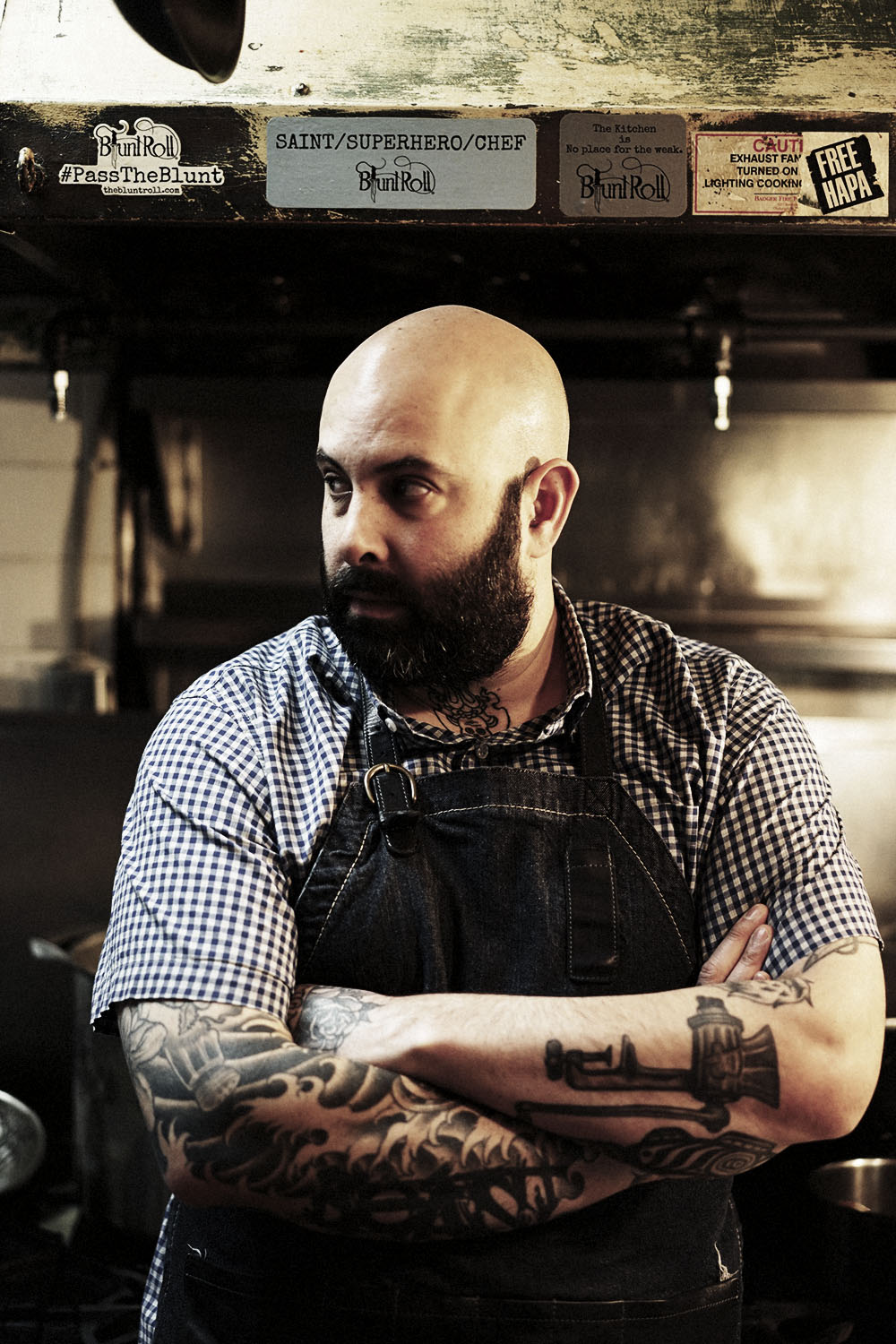
That sake and food really does work was made deliciously apparent to me over the course (or several courses, to be accurate) of some recent sake dinners, including the one whose menu prefaces this piece, which was the brainchild of Hatherell and staged at Toronto’s The Tempered Room. While not exactly “traditional” (and not exactly Japanese), it certainly helped demonstrate the ability of sake to match beautifully with not-exactly-Asian dishes. (More on that in a bit.) The other dinner events (and “events” is putting it mildly) took place again in Toronto, at ki modern Japanese + bar, and Miku, two upmarket Japanese dining establishments.
At these dinners, the fact that the sake and main courses worked together nicely wasn’t a huge surprise. The dishes served were complex, relatively subtle and often richly textured. The sake tended to fit the same profile: each one had a creamy mouth feel, balanced acidity and delicate-yet-intricate flavours that wrapped themselves around each bite. There were, however, a few definite surprises. Like sake and dessert.
My dinner at Miku wrapped up with a decadent but impossibly airy chocolate-mousse-like-thingamabob (Sorry, Chef, I didn’t get the actual name — though I doubt it was “thingamabob.” Blame the sake.). The next day, I again found that sake and chocolate made for cozy bedfellows at the Kampai seminar mentioned earlier, where sake specialist Mariko Tajiri led us through a tasting featuring, well, “unexpected” foods. Besides chocolate (great with Tengumai Yamahai Junmai), we also successfully married sake with fruit, cheese, pretzel sticks with Dijon mustard, and summer sausage, among other things. I was starting to wonder what sake wouldn’t work with. (Actually, the one thing it didn’t work with was an incredibly spicy salami, which wouldn’t have really worked with anything.)
“Sake is naturally a very versatile beverage and always seems to get along with food,” confirms Michael Tremblay, ki’s National Head Sake Sommelier and Canada’s first and only certified Advanced Sake Professional. “One of the reasons sake can work with even some of the foods that wine has a problem with — like asparagus, soy, wasabi — is that its composition is quite different than wine. For instance, sake has about a fourth of the acidity you would find in a glass of white wine. In addition, sake has a complex array of amino acids, including glutamic acid, which is one of the key ingredients in umami. Lastly, with the exception of a few over-the-top styles, the aromas in sake tend to be subtle and not intrusive when matching food.” Sake also doesn’t have any tannin — a blessing or a curse, depending on your predilections.
Sake also has a distinct advantage over wine when it comes to serving temperature. Tremblay elaborates: “I have had the pleasure of pairing food and sake for a multitude of sake dinners at ki. One of the most important tricks up my sleeve is the idea of serving temperature. Unlike almost every other alcoholic beverage on the planet, sake can be served at 55˚C or 5˚C. That’s a huge range. And what is most interesting is how different a sake’s profile will be if you serve it at several temperatures. Generally, when you warm a sake, you amp up its acidity, sweetness and umami, making it work well with dishes like pork belly, beef and game, or fatty fish.”
“Sake is naturally a very versatile beverage and always seems to get along with food.”
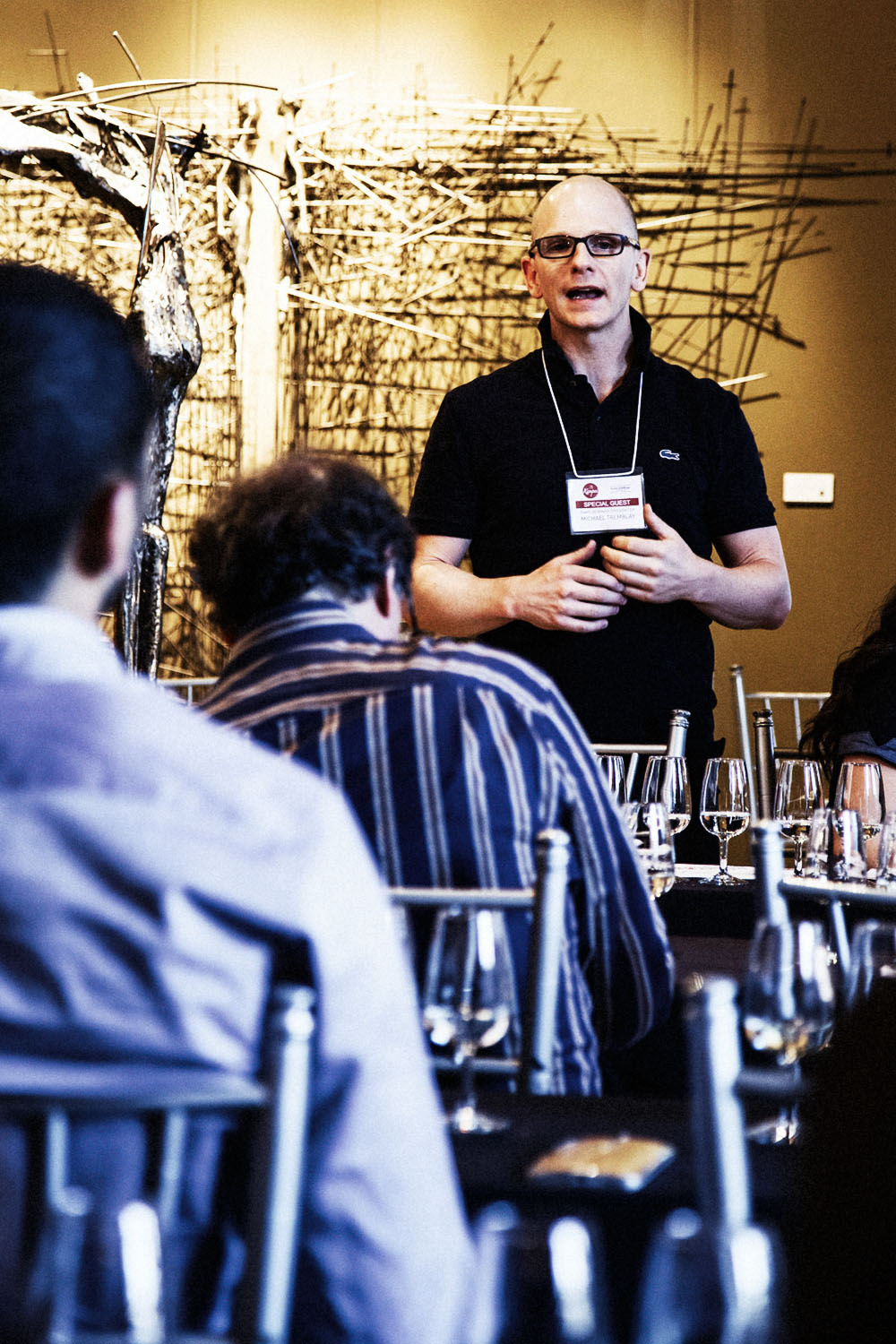
At the ki dinner, Tremblay put his money/sake where our mouths were, so to speak, pairing the same Wakatake Onikoroshi Tokubetsu Junmai Genshu chilled with seared scallops and warmed with sake-braised pork belly. The effect was almost startling; it was like pairing the dishes with two distinctly different drinks. And both matches were terrific. Try heating up that Sauvignon Blanc you were enjoying with the fresh oyster appy and then sip it with the rare steak main. Yeah, good luck.
Speaking of steak, you might figure a restaurant called Beast would be the last place you’d expect to find sake. But Chef Scott Vivian is a recent convert.
“I’ve always been fond of sake,” he admits. “But I never had the opportunity to taste different styles side by side. I knew that I wanted to create a small and somewhat accessible sake menu at the restaurant to complement the many Asian-inspired components that are on the menu at Beast. After sitting down and tasting through a gamut of bottles, I got a much better understanding of how versatile and complementary to all kinds of food sake can be. After putting together the list at Beast, I took the time to sit down and try some sake pairings with our dishes. I was pleasantly surprised that they went very well with the majority of the menu and realized that you could easily drink sake throughout the entire meal.
“The good part is that it is available in a few different sizes — 180 ml cans and bottles, 300 ml bottles and 720 ml bottles. This allows our patrons a variety to choose from. Something to start the dinner off, something to sip on during the first round of dishes and definitely something to enjoy throughout the entire meal.”
So, if your first memory of sake is somewhat like your first memory of rosé (likely not so special), I suggest you reconsider. I predict the sake revolution will escalate here in Canada — we typically get these things ahead of the curve.
Sake Sizes
You might have noticed that sake typically comes in bottle sizes that are pretty unique. No wine-bottle-sized 375, 750 or 1,000 ml, but rather, 180, 300 and 720 ml and 1.8 litre numbers. What gives?
I ask Mariko Tajiri, a sake specialist and national brand manager with That’s Life Gourmet Ltd. to clue me in. “The masu is the basic unit of measurement in Japan, and it is 180 ml,” she explains. “It’s the volume of the square wooden box used to measure rice in Japan during the Feudal period. Sake uses this unit of measurement, which is why a bottle of sake is traditionally 1.8 l (10×180 ml) or 720 ml (4×180 ml).”
I personally find the handy 180 ml size to be perfect for a single serving with dinner. “The 300 ml bottles were created as people in Japan started to consume less sake,” Tajiri reveals, “and for the export market.”
In any case, the higher alcohol content and unique constitution of sake ensure that an open bottle of sake will stay fresh in in the fridge for up to a couple weeks. But fresher is better!

